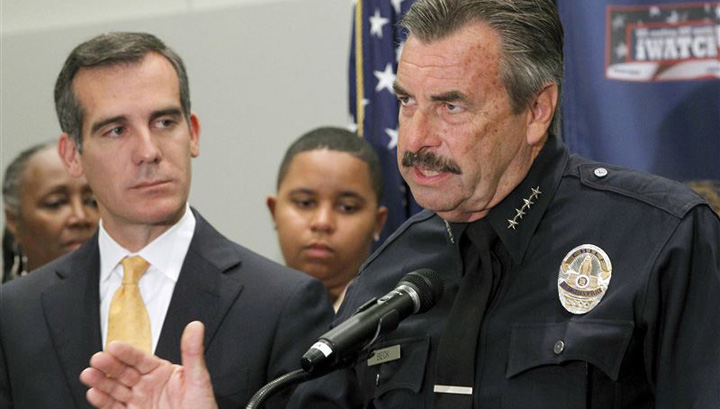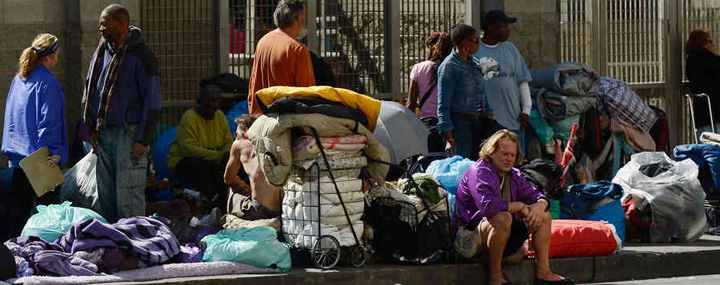Los Angeles violent crime surged by 67% downtown for the first six months of 2015 according to the FBI Uniform Crime Reports.
- Is the increase in violent crime caused by gang activity?
- Was it caused by the jail inmate’s early-release program?
- Is it related to the growing Skid Row Homeless Population?
- Did Proposition 47 felony crime reclassification cause the spike?

Mayor Eric Garcetti and Chief Charlie Beck’s press conference
Podcast Time Stamps:
- [00:45] – Press conference with Chief Beck and Mayor Garcetti.
- [01:48] – Interview with KABC talk-radio show host Peter Tilden.
- [02:30] – Why is Los Angeles violent crime increasing downtown?
- [03:55] – Los Angeles violent crime is up 67% downtown.
- [04:50] – More cops are not the answer to lowering crime statistics.
- [08:52] – My comments about the interview subject matter.
- [09:02] – What’s causing the spike in Los Angeles violent crime?
- [10:50] – Three-strikes law in California.
- [12:35] – Perfect Crime Storm.
- [13:00] – Early release of jail and prison inmates.
- [14:45] – Skid Row in Los Angeles.
- [15:20] – Proposition 47 and its contribution to the crime rate increase.
- [16:25] – LAPD modifies arrest and jail booking policy.
- [18:00] – Los Angeles Violent Crime analysis – Mystery in the numbers.
- [18:30] – FBI Uniform Crime Reports.
- [20:50] – LA Times investigated LAPD crime under-reporting.
- [23:15] – Predictions about crime trends in Los Angeles violent crime.
What caused the rise in Los Angeles violent crime downtown?
Was it caused by:
- A downtown gang turf battle.
- A surge in drug activity.
- A major new entertainment or sports venue opening.
- Rising homelessness and violence on Skid Row.
- Discharge of jail inmates due to overcrowding.
- Proposition 47 downgrading felonies to misdemeanors.
- Change in offender arrest and jail booking policy.
- Changes in LAPD policy on crime classifications.
- Increased part-1 UCR crime reporting to the FBI.
- Violent crime was under-reported in 2104.
- Violent crime data correction in 2015.
- A combination of several of these factors.
California was Tough on Crime
The three-strikes law in California was legislation that mandated the courts to impose harsher jail and prison sentences on habitual offenders. The sentencing threshold was having at least two-prior serious criminal convictions and has now committed a third. In California, even a misdemeanor drug crime conviction could be that third-strike triggering harsher jail or prison sentence.
The idea was to be tough on crime by keeping those more likely to commit a serious crime off the streets and separate habitual offenders from society using the baseball analogy of three strikes and you’re out.
The Perfect Crime Storm
However, this crime reduction benefit came at a high price. The Los Angeles County jail quickly became overcrowded with those awaiting trial and sentencing. The inmate congestion and deplorable housing conditions in the county jail were condemned by everyone.
Early Release from Jail
Beginning in 2013-2014 the City and County of Los Angeles began to early-release “low-risk” jail inmates at a significant rate. Relevant to this discussion is that the largest jail complex in the United States, the Twin Towers, and Men’s Central Jail correctional facility, is located in downtown Los Angeles in the LAPD Central Division.
According to a statewide audit, by June 2014 California jails were releasing 14,000 inmates per month after serving 20% or less of their sentence while also reducing the state prison population by over 25,000. With all this happening in a relatively short time span, it was no surprise to hear about the rise in crime announcements by city officials.
Los Angeles Skid Row
Many inmates that are suddenly released don’t have any place to go. They simply walk out the front door of the correctional facility and onto the public streets of downtown Los Angeles. Some will end up on Skid Row where police reports show a sharp rise in aggravated assaults among the homeless population.

Los Angeles Skid Row
Crime Reclassification of Felony down to Misdemeanor
In an effort to further reduce jail and prison overcrowding, California voters passed Proposition 47 in November 2014. This measure authorized the courts to reduce and reclassify certain “low-risk” felony drug and theft convictions and future offenses down to misdemeanors. The impact was that certain jail inmates awaiting sentencing on felony convictions were discharged with time served under the new guidelines.
Early Release from State Prison
Certain convicted state prison inmates could apply to have their convictions and sentences downgraded and apply for immediate release. This policy change resulted in the premature release of about 3,700 formerly convicted felons back into society. Conviction downgrades will affect how future offenses might be charged and what sentencing guidelines might be applied by the court.
The change in law also allows for felony criminal records to be amended to reflect misdemeanor convictions despite a jury finding otherwise. This will undoubtedly have a cascading effect on criminal record checks, background investigations, and employment and housing application guidelines.
It’s a confusing time for sure.
Is LAPD Law Enforcement Being Undermined?
LAPD arrest policy was modified in 2014 to reflect the new Prop 47 regulation. Previously, felony offenders were being jailed. Now, “less serious” drug and theft offenders are being released on the street with criminal citations and a “promise” to appear in court.
The bottom line is that in 2015 many criminal offenders including gang members are back on the street quicker than before. Until the alleged Los Angeles crime surge is studied, it’s too soon to tell which policy change, if any, had the greatest correlation to this recent spike in crime.
Crime Analysis
Crime analysis depends on accurate incident reporting data from year to year for trends to be deemed reliable. Since 1935, the United States and FBI established a Uniform Crime Reports (UCR) system so that there are consistency and reliability in the data. Most law enforcement agencies in the United States submit Part-1 * and Part-2 * crime report data that represents a cross-section of crime that affects about 93% of the population.
The public and criminal justice system relies on law enforcement agencies to accurately create crime incident reports and correctly report the data to the UCR system every month. Crime reports submitted to the UCR are supposed to reflect police officer-generated reports and not the pled-down adjudicated version.
These Uniform Crime Report publications are then used by law enforcement commanders, the media, politicians, the business community, and tourism public relations to make judgments about the crime rate of cities and neighborhoods.
Crime data, like any other numerical accounting system, requires accuracy and integrity to have credibility. Any time there are incentives or chastisements connected to the rise or fall of crime statistics there is motivation to manipulate the numbers so independent audit and scrutiny are needed.
LA Times Investigated LAPD and Los Angeles Violent Crime Reporting
The Los Angeles Times newspaper sometimes acts as a watchdog over public agencies. In 2012-2013 the LA Times investigated Los Angeles violent crimes reported by LAPD and discovered that nearly 1,200 violent crimes were misclassified by the agency including hundreds of robberies, stabbings, and beatings.
According to an August 2014 LA Times article, most of the misclassification involved under-reporting aggravated assaults as simple assaults, which caused an under-reporting of Part-1 crimes to the FBI UCR system by almost 14%.
If this was intentional it would falsely indicate that Los Angeles violent crime is being controlled when it was not. Even if the misclassification and reporting were made in error, it would affect policy decisions about enforcement, budget, allocation of resources, and the accuracy of proclamations to tourists about the relative safety of Los Angeles.
What Needs to be Done
I don’t know at this time what policy changes were made by LAPD to increase the accuracy of reporting, but I do know that with many thousands of crime reports generated it is a very complex task.
- Like any accounting system, under-reporting numbers will eventually lead to a spike in trends when errors are caught or exposed and accurate reporting prevails.
- It’s too soon to tell what will shake out of the investigation into the Los Angeles crime surge.
- If errors are involved the crime trend should self-correct with an equalizing plunge in numbers.
- If the crime rate continues to rise then a plan of action needs to be clearly defined and articulated to relevant agencies.
- I’m sure that the relevant agencies within the City and County of Los Angeles were given the mandate to analyze the data at the macro level and try to make sense of it all.
See the related shows about Apartment building takeover by Los Angeles gang members.
Things Mentioned in this Episode
- KABC Talk Radio with Peter Tilden – Live at Six.
- KTLA TV News Story about Los Angeles violent crime surge.
- Broken Windows theory to LAPD policing:
- Former LAPD Chief Bratton applied the broken windows concept for crime prevention. It is a criminology theory first articulated by James Q. Wilson and George L. Kelling about the norm-setting and signaling effect of urban disorder and vandalism on additional crime and anti-social behavior.
- Three Strikes Law
- California’s Three-Strikes sentencing law was enacted in 1994. The law originally mandated a state prison term of at least 25 years to life for habitual offenders. Prop 36 amended the law in 2012 and modified many of the conditions.
- Los Angeles Skid Row
- Thousands of homeless people live on the streets in downtown Los Angeles in an area east of Main Street, south of Third Street, west of Alameda Street, and north of Seventh Street
- FBI UCR Part-1 Crimes *
- Violent crimes include homicide, rape, robbery, aggravated assault
- Property crimes include burglary, theft, auto theft, arson
- FBI UCR Part-2 Crimes *
- Simple assault, curfew offenses, loitering, embezzlement, forgery and counterfeiting, disorderly conduct, driving under the influence, drug offenses, fraud, gambling, liquor offenses, offenses against the family, prostitution, public drunkenness, runaways, sex offenses, stolen property, vandalism, vagrancy, and weapons offenses.
Learn More about Premises Liability Litigation
Download the 115-page eBook written by Security Expert Chris E. McGoey
- Security Expert’s Guide to Premises Liability Litigation
- Evaluating Crime Foreseeability and Inadequate Security Cases
Chris McGoey has authored a tremendous practical guide about premises liability litigation for attorneys, security consultants, risk managers, landlords, law enforcement, and business operators.
“You won’t find a better book on this subject!”
If you’re a trial lawyer, you simply “Must Read This Book”
- 115 pages 8.5 X 11″ — Instant Download (PDF) – Revised 2023.
Copyright © 2009 – 2023 Aegis Books, Inc.
Click the Buy Now button. Pay via PayPal or Credit-Debit Cards
Instant Download $25 –
- Online Orders are Secure via PayPal Server
- Unconditional Money-Back Guarantee
Biography of Chris E. McGoey
Testimonials from a few clients
Premises Liability Litigation Book
Retain Chris as a Security Expert Witness
Contact Security Consultant Chris E. McGoey
Jonesborough, Tennessee
